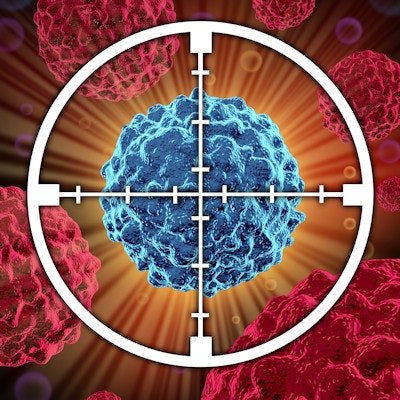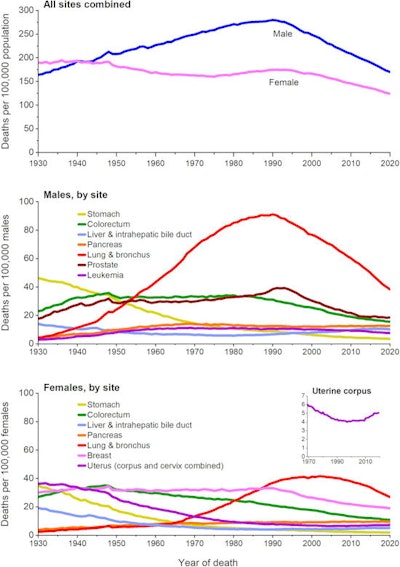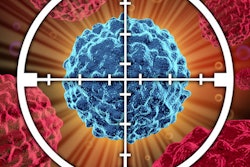
Cancer mortality rates continue to drop thanks to prevention and screening programs, yet rising incidence for breast, prostate, and uterine corpus cancers could impede future progress, according to a new report from the American Cancer Society (ACS).
These cancers also have the largest racial disparities, according to the ACS. Overall, the ACS found that overall cancer mortality has dropped 33% since 1991, averting an estimated 3.8 million cancer deaths. In 2023, the ACS projects there will be 1,958,310 new cancer cases and 609,820 cancer deaths in the U.S.
Each year, the ACS estimates the numbers of new cancer cases and deaths in the U.S. and compiles the most recent data on population-based cancer occurrence and outcomes. The latest findings were published January 12 in CA: A Cancer Journal for Clinicians.
Two of the report's most critical findings are driven by substantial changes in cancer prevention and screening in the last decade, according to the ACS.
 Trends in cancer mortality rates by sex overall and for selected cancers, U.S., 1930-2020. Rates are age-adjusted to the 2000 U.S. standard population. Because of improvements in International Classification of Diseases coding over time, numerator data for cancers of the lung and bronchus, colon and rectum, liver, and uterus differ from the contemporary time period. For example, rates for lung and bronchus include pleura, trachea, mediastinum, and other respiratory organs. Image and caption courtesy of the ACS and CA: A Cancer Journal for Clinicians under CC BY 4.0 International license.
Trends in cancer mortality rates by sex overall and for selected cancers, U.S., 1930-2020. Rates are age-adjusted to the 2000 U.S. standard population. Because of improvements in International Classification of Diseases coding over time, numerator data for cancers of the lung and bronchus, colon and rectum, liver, and uterus differ from the contemporary time period. For example, rates for lung and bronchus include pleura, trachea, mediastinum, and other respiratory organs. Image and caption courtesy of the ACS and CA: A Cancer Journal for Clinicians under CC BY 4.0 International license.First, there was an astounding 65% reduction in cervical cancer rates in women ages 20-24 from 2012 through 2019, according to the report. The reduction is believed to come in the wake of the introduction of the human papillomavirus (HPV) vaccine.
"The large drop in cervical cancer incidence is extremely exciting because this is the first group of women to receive the HPV vaccine, and it probably foreshadows steep reductions in other HPV-associated cancers," said lead author Rebecca Siegel of the ACS in a statement.
Second, by contrast, the diagnosis of advanced-stage (regional or distant stage) prostate cancer has increased by 4% to 5% annually and the proportion of men diagnosed with distant-stage disease has doubled. The incidence increased for prostate cancer by 3% annually from 2014 through 2019 after two decades of decline, translating to an additional 99,000 new cases, the ACS found.
"We must address these shifts in prostate cancer, especially in the Black community, since the incidence of prostate cancer in Black men is 70% higher than in white men," stated Dr. William Dahut, ACS chief scientific officer.
Other highlights in the report include the following:
- Female breast cancer incidence rates have been slowly increasing by about 0.5% per year since the mid-2000s, largely driven by diagnoses of localized-stage and hormone receptor-positive disease.
- Uterine corpus cancer incidence has increased by about 1% per year since the mid-2000s among women ages 50 and older and nearly 2% per year since at least the mid-1990s in younger women.
- After decades of increase, thyroid cancer incidence rates have declined since 2014 by about 2% per year because of changes in clinical practice designed to mitigate overdetection.
- Lung cancer incidence has declined at a steady pace since 2006-2007 by 2.6% annually in men and by 1.1% annually in women.
In addition, despite the pandemic, and in contrast with other leading causes of death, the cancer death rate continued to decline from 2019 to 2020 (by 1.5%), contributing to a 33% overall reduction since 1991 and an estimated 3.8 million deaths averted, the ACS reported.
As for the alarming trends in prostate cancer, ACS Chief Executive Officer Dr. Karen Knudsen said that the organization is launching a new initiative called IMPACT, an acronym for Improving Mortality from Prostate Cancer Together, to address racial disparities.
The IMPACT initiative will fund new cancer research programs that connect the laboratory, the clinic, and the community, she said.
"ACS is committed to utilizing a tripartite strategy to reverse prostate cancer disparities and reduce death rates from prostate cancer in all demographics and disparities for Black men by 2035," Knudsen said in a statement.



















